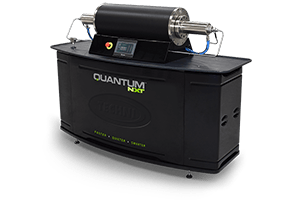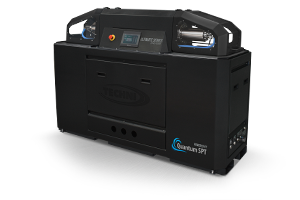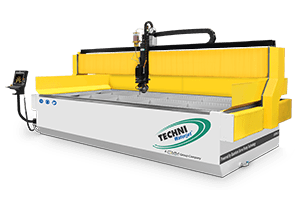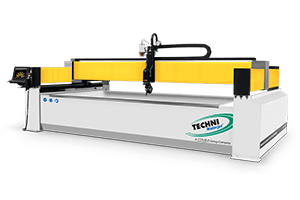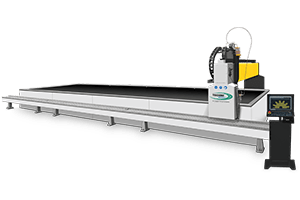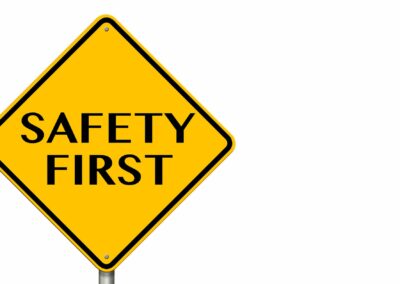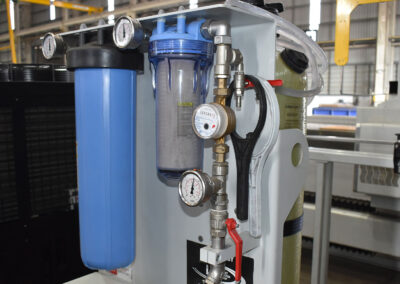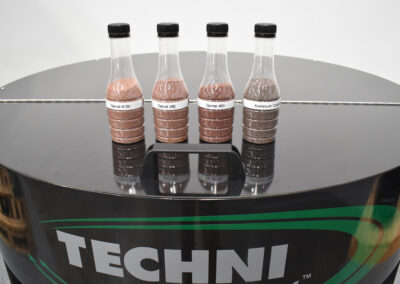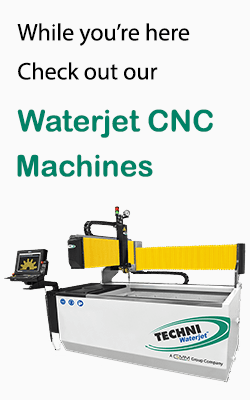Waterjet cutting is quickly becoming a popular method for cutting through different materials with unmatched precision, but how well does it cut through vinyl?
Applying heat to vinyl is a fast way to compromise its quality and luckily with waterjet technology, such heat is not generated.
When you use the right waterjet cutting machine from a reliable manufacturer, you can be certain your vinyl projects will be executed with high accuracy, flexibility, and durability.
In this article, we’ll focus on the concept of waterjet cutting on vinyl, and the pros and cons attached to this technology.
Can Vinyl Be Cut Using a Waterjet Cutter?
Yes, vinyl can be cut effectively using a waterjet cutter. Vinyl, a popular material in various industries, is compatible with waterjet cutting technology because it can be sliced accurately without the risk of melting or warping.
Waterjet cutting’s ability to operate without generating heat is especially valuable in processing vinyl, as this material can be sensitive to high temperatures. By avoiding heat damage, waterjet cutters maintain the integrity of the vinyl’s design and structure.
How Does Waterjet Cutting Work for Vinyl?
Waterjet cutting technology relies on high-pressure water streams, often combined with abrasive materials, to create sharp, clean cuts. When cutting vinyl, which is sensitive to heat, waterjet technology stands out as an ideal choice because it operates without generating heat that might distort the material.
Whether you’re looking to achieve complex designs, accurate shapes, or small details in vinyl, waterjet cutting is versatile enough to meet these needs.
What Are the Steps Involved in Preparing Vinyl for Waterjet Cutting?
Before you begin cutting vinyl with a waterjet machine, it’s essential to follow specific steps to prepare the material and equipment effectively. Here’s a breakdown of the necessary steps to achieve precise, high-quality cuts:
- Choose the Right Type of Vinyl: Selecting the correct vinyl type is the first step. Vinyl comes in different varieties, such as PVC and VCT, each with its specific properties. Knowing the material’s characteristics helps determine the ideal water pressure and cutting parameters.
- Ensure Clean, Flat Surfaces: Begin with clean, flat vinyl sheets or rolls to reduce inconsistencies during the cutting process. Dirt or uneven surfaces can affect the cutting accuracy and the final quality of the edges.
- Set the Water Pressure and Nozzle Size: Adjusting the water pressure and nozzle size is crucial when cutting vinyl, as these factors directly impact the quality of the cut and the machine’s efficiency. Using the right settings ensures smooth edges and reduces the risk of vinyl warping.
- Secure the Vinyl Properly: Position and secure the vinyl sheet on the cutting table. This minimizes movement during cutting and maintains precise alignment with the water stream.
- Run a Test Cut: Performing a test cut on a sample piece of vinyl allows you to assess the chosen settings. It’s a valuable step to confirm that the water pressure, nozzle, and speed are set correctly for the specific vinyl material.
What Types of Vinyl Can Be Cut with Waterjet?
When choosing the best type of vinyl for a project, understanding these properties is crucial, as each variation requires different handling techniques to ensure a clean, accurate cut.
Below are several types of vinyl suitable for waterjet cutting, along with their physical and chemical properties that affect the cutting process.
- PVC (Polyvinyl Chloride): PVC is a widely used vinyl type that can be cut effectively with waterjet technology. Known for its durability and resistance to moisture, PVC is popular in signage, flooring, and various industrial applications. It responds well to waterjet cutting, as the process produces minimal heat, preventing warping or melting.
- VCT (Vinyl Composition Tile): VCT is a durable vinyl option commonly used in flooring, especially in commercial settings where high traffic is expected. VCT is highly resilient and works well with waterjet cutting because it maintains its shape under the high-pressure water stream. This material’s composition also reduces issues related to fumes, which can occur in other cutting methods.
- Foamed PVC: Foamed PVC is a lighter version of standard PVC, often used in signage and decorative applications. Its lightweight nature makes it easier to cut, but it requires lower pressure settings to avoid damage. Waterjet cutting allows for precise cuts on foamed PVC without causing fraying or compromised edges.
- Flexible Vinyl: Flexible vinyl, often used in automotive and marine applications, requires careful handling when waterjet cutting. This type of vinyl has a higher tolerance for bending and can be cut into intricate designs. However, securing flexible vinyl properly on the cutting surface is essential to avoid shifts during the cutting process.
What Equipment and Machinery is Essential When Waterjet Cutting Vinyl?
To achieve the best results when cutting vinyl, using the right waterjet cutting equipment is essential.
Below is a list of crucial equipment, along with descriptions of how each piece contributes to successful vinyl cutting projects.
- Waterjet Cutting Machine: The main tool in any waterjet cutting setup, a waterjet cutting machine is designed to cut various materials using high-pressure water or a mix of water and abrasive particles. Machines tailored for vinyl cutting typically allow you to adjust the water pressure to avoid damaging the material.
- High-Pressure Pump: A high-pressure pump generates the water stream used in waterjet cutting. For vinyl, adjusting the pressure is key to achieving a clean cut. The pump’s strength is essential for precise cuts, allowing the waterjet machine to maintain consistent pressure for high accuracy.
- Abrasive Feeder System: While not always necessary for softer materials like vinyl, an abrasive feeder can add particles to the water stream when additional cutting force is required. This system is beneficial for thicker vinyl types or those combined with other materials, such as layered composites.
- Nozzle and Cutting Head: The nozzle is where the high-pressure water exits to make the cut. Choosing the right nozzle size and type helps control the cut’s sharpness and reduces waste. For intricate vinyl designs, a finer nozzle ensures precision without excess water spray that might affect nearby areas of the material.
- Secure Cutting Bed: A stable, secure cutting bed holds the vinyl in place during the process, reducing movement and maintaining alignment. For flexible or foamed vinyl, this is particularly important, as these types are more prone to shifting.
- Filtration and Recycling System: To maintain an efficient and eco-friendly operation, waterjet setups often include a filtration and recycling system. This equipment cleans the water after use, removing particles and contaminants, allowing for reuse and reducing water waste.
What Are the Benefits of Using Waterjet Technology for Cutting Vinyl?
Waterjet technology offers a precise, versatile, and environmentally friendly approach to cutting vinyl, making it an excellent choice for a wide range of applications.
Here are several key benefits that waterjet cutting brings to vinyl projects, each enhancing both the process and the final product.
- Precision: Waterjet cutting allows for highly accurate cuts, even on intricate vinyl designs. The precision achieved by this method ensures that complex patterns, logos, and shapes can be produced without errors. With waterjet technology, vinyl can be cut to exact specifications, preserving the material’s integrity and enhancing the quality of the finished product.
- Versatility: Waterjet cutters can handle various vinyl types, including PVC and VCT, without compromising quality. This versatility is beneficial for businesses that work with multiple materials or need to create diverse products, from tiles to flooring. The ability to adjust water pressure and nozzle settings allows operators to tailor the cutting process for specific vinyl types, making it adaptable for different projects.
- Eco-Friendliness: Unlike other cutting methods that produce heat or release fumes, waterjet cutting uses only water, with minimal environmental impact. The absence of heat during the cutting process is especially advantageous for vinyl, as it prevents material distortion and minimizes waste. Additionally, many waterjet systems include filtration and recycling features that conserve water, making the entire operation more sustainable.
- No Heat-Affected Zones: Vinyl is sensitive to high temperatures, which can lead to warping or discoloration. Waterjet cutting avoids this by using a cold-cutting process, ensuring that the material remains intact and its appearance unaltered. This feature is valuable for industries requiring precision without risking damage to the vinyl’s surface.
- Smooth Edges: Waterjet cutting produces clean, smooth edges on vinyl, eliminating the need for additional finishing steps. This edge quality improves the overall appearance of the product and reduces production time, as there is no need for secondary trimming or sanding.
- No poisonous fumes emitted due to the cold cutting process.
What Are the Applications of Waterjet Cutting in the Vinyl Industry?
Waterjet cutting technology is widely used across various sectors of the vinyl industry, providing a range of applications that meet both aesthetic and functional needs.
The flexibility of waterjet technology allows businesses to create products with complex designs, making it ideal for projects that require customization and precision.
- Signage: Waterjet cutting is ideal for producing detailed vinyl signage, including company logos and lettering for commercial use. The precision of waterjet technology allows for the creation of complex shapes and intricate designs, ensuring that brand elements like logos are both accurate and visually appealing.
- Automotive Wrapping: In the automotive industry, vinyl wraps are popular for customizing vehicle exteriors. Waterjet technology can cut wrap designs to fit exact vehicle specifications, allowing for precise application with minimal trimming. This process helps reduce waste and ensures a seamless fit around edges and curves.
- Flooring Tiles: Vinyl composition tiles (VCT) are widely used in commercial flooring, and waterjet cutting provides an efficient way to produce these tiles to exact specifications. The process can accommodate custom shapes and sizes, enabling unique flooring designs that stand out in retail spaces, hotels, and offices.
- Decorative Inlays: Waterjet cutting enables the creation of decorative inlays on vinyl, which can be used in furniture, flooring, or wall panels. These inlays add aesthetic value to products by incorporating detailed designs and patterns, giving businesses a way to offer customers unique, personalized options.
- Industrial Equipment Labels: Vinyl is also used for labeling and marking industrial equipment due to its durability and resistance to wear. Waterjet cutting allows for accurate and durable labels that can withstand harsh environments, making it a preferred choice for labels on machinery and factory equipment.
- Custom Shapes and Designs: Beyond standard applications, waterjet cutting is useful for custom projects that require unique shapes or detailed designs. This flexibility allows manufacturers to meet specialized requests, from custom vinyl parts for consumer products to unique logo shapes for branding.
What Are the Key Parameters to Monitor During Waterjet Cutting of Vinyl?
When working with vinyl, specific parameters in the waterjet cutting process must be carefully monitored to achieve high-quality results. These parameters directly influence the precision of the cuts, the durability of the equipment, and the overall outcome of the project.
Let’s discuss the five most important parameters to keep in check and how each affects the cutting process:
- Water Pressure: Water pressure is one of the most critical settings in waterjet cutting, especially for vinyl. Adjusting the water pressure to match the thickness and type of vinyl ensures a smooth cut without damaging the material. High pressure provides sharp cuts for thicker vinyl types like VCT, while lower pressure settings are suitable for more flexible or thin vinyl materials.
- Cutting Speed: The speed at which the waterjet moves across the vinyl is essential for achieving a balance between precision and efficiency. Faster cutting speeds can sometimes lead to rough edges, especially in intricate designs, while slower speeds allow for smoother, cleaner cuts. Adjusting the speed based on the design and vinyl type helps control the quality of the edges.
- Abrasive Type and Flow Rate: Though not always necessary for vinyl, abrasives can be added to the water stream for thicker or composite vinyl materials. When used, selecting the right abrasive type and flow rate is vital. Too much abrasive can damage vinyl’s surface, while too little may not achieve the desired cut quality. This setting is often adjusted based on the material’s thickness and required edge sharpness.
- Nozzle Size: The size of the waterjet nozzle impacts the precision of the cut and the amount of water used. A finer nozzle size is ideal for detailed cuts and intricate vinyl designs, as it allows for a more controlled stream. Larger nozzles may be used for simpler shapes where less precision and more speed is required.
- Stand-Off Distance: The distance between the nozzle and the vinyl, known as stand-off distance, influences the quality of the cut. A consistent and optimal stand-off distance ensures that the water stream maintains its power and direction, resulting in a clean cut without over-spraying or weakening the edges.
What Settings Are Optimal for Cutting Vinyl with a Waterjet?
Each setting, from water pressure to nozzle size, impacts the quality of the cut and the efficiency of the process. Here’s a breakdown of the optimal settings to use when working with vinyl materials.
- Optimal Water Pressure: For vinyl, maintaining a moderate water pressure range is typically most effective. Around 30,000 to 50,000 psi is common for vinyl cutting, depending on the thickness and type of vinyl. High-pressure settings are best suited for thicker vinyl sheets, while lower pressures work well for more flexible or thin vinyl types.
- Nozzle Size Recommendations: Choosing the right nozzle size is essential, as it determines the control and accuracy of the water stream. A smaller nozzle, typically around 0.07 to 0.09 inches in diameter, provides detailed control for intricate designs. For simpler cuts, a larger nozzle may be suitable, but always consider the level of detail required for the specific project.
- Abrasive Flow Rate: If abrasives are required for a particular vinyl type, setting a low abrasive flow rate helps prevent damage. For most vinyl applications, an abrasive flow rate of around 0.25 to 0.50 pounds per minute is recommended. This rate provides the cutting strength needed without risking the material’s surface or causing excessive wear on the equipment.
- Cutting Speed Adjustments: Adjusting the cutting speed is necessary to balance efficiency with cut quality. For vinyl, around 200 to 300 inches per minute, yield smoother edges and are especially beneficial for complex designs. Higher speeds can be used for straightforward cuts but may lead to rougher edges if not carefully monitored.
- Stand-Off Distance for Precision: Setting the correct stand-off distance, or the gap between the nozzle and the vinyl, helps achieve a clean cut. An optimal distance is typically between 0.04 and 0.08 inches. Keeping this distance consistent helps the water stream maintain its power and direction, resulting in smooth, accurate edges.
What Safety Measures Should Be Followed When Cutting Vinyl with a Waterjet?
Waterjet cutting, while effective, requires careful attention to safety to protect both the operator and the equipment.
Vinyl, like many materials, presents unique challenges when cut with high-pressure water jets, including potential debris, fumes, and operational hazards. Here are essential safety measures to follow to minimize risks and ensure a safe cutting environment.
- Wear Personal Protective Equipment (PPE): Eye protection, gloves, and ear protection are necessary when working with waterjet cutting equipment. The high-pressure stream can generate fine debris that could pose a risk to exposed skin or eyes. PPE reduces the risk of injury and protects against unexpected hazards during operation.
- Maintain Safe Distance from the Cutting Area: The high-pressure stream used in waterjet cutting requires distance from the nozzle and work area to avoid accidental contact. Even a brief exposure to the jet stream can cause injury. Keeping a safe distance reduces the risk of accidents while allowing operators to monitor the process.
- Inspect Equipment Regularly: Routine checks of the waterjet cutting machine, including nozzles, high-pressure pumps, and abrasive feeders, help ensure safe operation. Worn parts can lead to equipment malfunction, which poses additional safety risks. Regular maintenance keeps the equipment in optimal condition, supporting both safety and performance.
- Use Proper Material Handling Tools: Handling vinyl sheets or tiles requires stability to prevent slipping during the cutting process. Specialized clamps or holders secure the vinyl material on the cutting bed, reducing movement and improving safety. Secured materials are less likely to shift under the high-pressure stream, contributing to better cutting accuracy and operator safety.
What Are Common Challenges in Waterjet Cutting Vinyl and How to Overcome Them?
Waterjet cutting vinyl presents unique challenges, from managing material flexibility to preventing heat damage.
Here are some common issues encountered with vinyl and strategies to overcome them.
- Material Flexibility: Vinyl can be flexible, especially in thinner sheets, which can lead to movement or displacement during cutting. To address this, securing the vinyl with specialized clamps or adding a secure cutting bed can stabilize the material, ensuring precise cuts. Additionally, adjusting the water pressure to suit the vinyl type helps minimize the chances of warping or shifting.
- Edge Fraying: Some types of vinyl are prone to frayed edges if the waterjet pressure is too high or if the nozzle size is incorrect. Using a smaller nozzle and moderate pressure can reduce fraying, creating cleaner edges. Testing on a sample piece of vinyl before full production helps determine the optimal settings for clean edges.
- Heat-Sensitive Material: Vinyl is sensitive to heat, and although waterjet cutting is a cold process, prolonged cutting or high-pressure settings may cause slight material distortion. Monitoring the duration and pressure of each cut can help prevent heat buildup. Adjusting the stand-off distance between the nozzle and material may also help manage heat levels, especially on heat-sensitive vinyl.
- Precision in Complex Designs: Cutting intricate designs into vinyl can be challenging, particularly with fine details. To enhance precision, use a finer nozzle and slower cutting speed. This approach allows the waterjet stream to follow complex patterns more accurately, minimizing the risk of errors.
How Do You Choose the Right Waterjet Machine for Cutting Vinyl?
With various machines on the market, each offering unique features and capabilities, knowing what to look for can make all the difference in your cutting process.
Here are seven key features to consider when choosing a waterjet machine tailored for vinyl cutting needs:
- Adjustable Water Pressure: Precision is critical when cutting vinyl, and having a machine with adjustable water pressure allows you to adapt to different vinyl types, from flexible PVC to more rigid VCT. Look for a machine that lets you control the pressure range accurately to prevent unnecessary wear on the material.
- Nozzle Size Options: The nozzle size impacts the detail and quality of each cut. Smaller nozzles provide more control for intricate designs, while larger nozzles work well for straightforward cuts. Choosing a machine with customizable nozzle sizes gives you flexibility, allowing you to tackle both detailed and simple projects efficiently.
- Abrasive Feed System (Optional): While vinyl cutting often doesn’t require abrasives, some applications with thicker or composite vinyl types may benefit from this feature. Machines with an optional abrasive feed system allow you to switch between pure waterjet cutting and abrasive cutting, broadening the range of projects you can undertake.
- User-Friendly Interface: Operating a waterjet machine with a clear, user-friendly interface is crucial for efficiency. Look for machines with easy-to-navigate controls and intuitive settings. This feature is particularly valuable for quick setup adjustments, helping you minimize setup time and focus more on the actual cutting process.
- Sturdy Cutting Bed and Material Holders: Securing vinyl during the cutting process is essential to prevent movement. A machine with a sturdy cutting bed and reliable material holders will keep the vinyl in place, resulting in precise cuts. Stability in the cutting bed reduces the risk of misalignment and helps maintain high-quality edges. A wide range of pure water only cutting beds are available.
- Efficient Filtration: Water conservation and cleanliness are important for maintaining your equipment and reducing operational costs. Choosing a machine with an efficient filtration the waterjet stream clean and reduces waste, allowing for more sustainable operations.
- Maintenance Support and Service Availability: Regular maintenance is essential to keep your machine running smoothly. Machines with accessible service and support options reduce downtime and ensure any issues are resolved quickly. A reliable service team or support line can be a valuable asset when maintaining high production standards.
Conclusion
With the right equipment, careful setup, and a focus on safety, waterjet cutting becomes a reliable tool for making high-quality vinyl products suited to any application.
Whether you’re working on detailed designs or large batches, the flexibility and accuracy of waterjet technology make it a go-to choice for vinyl cutting, raising the bar for precision and efficiency in the industry.

